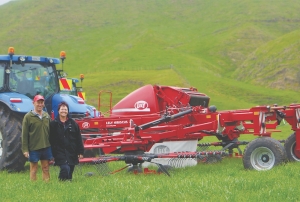So he’s he’s sticking with Lely, he says. “I won’t change from Lely because I’ve had such a good run with them.”
Carey and wife Sandra own a farm and run a contracting business, making balage and hay and doing general cultivation.
It’s a two-person operation: Carey does the mowing and baling, and Sandra does the raking, wrapping and most of the stacking. Together they make 6000 bales a season.
They’ve had a lot of Lely mowers over the 19 years they’ve been at their current property. Carey says one of the initial attractions was the service from the Lely dealers, Giltrap in Otorohanga, and the fact the mower needed low power. He is now on his sixth Lely mower.
The latest one is a Splendimo 320MH centre pivot and was new last season.
“Centre pivot mowers follow the ground far better,” Carey says. “There is less stress on the mower at the end of the cutter bar.” Few of the paddocks the Careys work are flat so the centre pivot is vital.
“In a lot of places the tractor is leaning one way and the mower the other. If you’re going through a V-shape valley with the tractor on one-side, the mower will lift up to 35° on the other side of the bank.
“The Splendimo 320MH copes equally well with grass and oats in any conditions. It flies through whether it’s long, short, wet or thick. Also the hydraulic break
away system works extremely well.”
Carey says the blades are quick and simple to change. The option he ordered has two inner and two outer swath discs on the cutting bar to bring in the swath in so Sandra can rake up three mower widths.
In 2011 Ron and Sandra bought a Lely Hibiscus 805 rake. They looked at a model with adjustable width through two hydraulic rams but they decided that an older model suited them better, because they always leave it on the maximum width anyway.
“The Hibiscus is built like the brick proverbial. It has lots of cam settings but we don’t change them either. Mike Walsh, a representative from Lely’s head branch in Hamilton, came down with the rake. He set it up for us, and we haven’t altered it since. He spent half a day showing how to work it.”
Sandra rakes with her 180hp tractor but Carey says 80hp or 90hp would be enough.
The rake has made it much easier to form a bale. “It makes me look really good when I’m baling. Some of it is Sandra, as she knows how to rake a paddock, and some is the rake. It lifts up and folds in the outside of the row, so when you’re baling you’re not zigzagging down the row. There’s more grass on the outside of the row and it makes nice square sides on the bale.”
The Careys’ baler is a Lely too – a 2009 Welger RP435 variable round baler. For hay, Ron makes up to 15 bale equivalents and around 10 for silage. It has optional knives, and a drop floor for blockages.
“The day I got it was the first time for ages I’d come home with a smile on my face. You just don’t have to get out of the tractor. If it blocks you just drop the floor, the blockage sucks through, raise the floor and you’re away again.”
The RP435 does not get blocked often. “I saw a demo before I bought one. It was a drizzly day with wet-as grass that had just been cut. The baler was fair flying around. Someone made a heap of grass just to block it. You could hear the baler working but it kept going. It just went straight through it.”
Carey likes the fact that the RP435 is stable on hills. “I feel safe on the side of hills even with a full bale.”

















